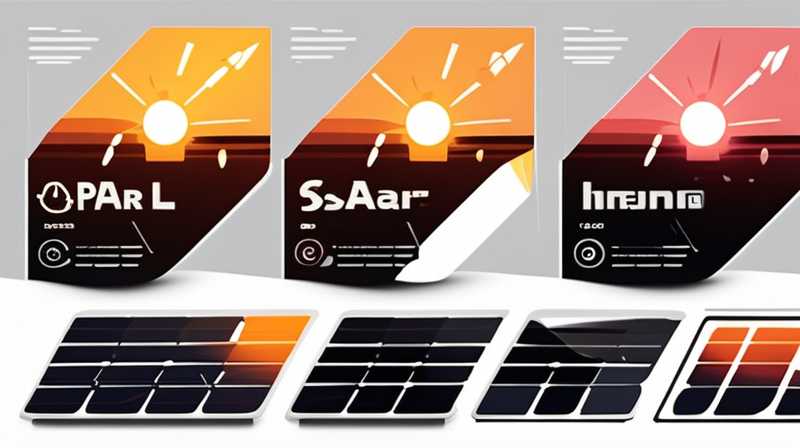
To determine the wattage of monocrystalline solar panels, one must consider several factors rooted in panel specifications and performance metrics. 1. Understand the rated power, 2. Evaluate efficiency, 3. Investigate real-world output, 4. Factor in environmental elements. Among these, understanding the rated power is critical as it indicates the maximum electric power produced under standard test conditions (STC) which are ideal sunlight and temperature conditions.
1. UNDERSTANDING RATED POWER
Understanding rated power involves recognizing what the specifications mean when examining monocrystalline solar panels. Each panel is assigned a wattage rating indicating its peak performance. This number, usually seen on the panel’s nameplate or in the product documentation, suggests how much power the panel can generate under ideal conditions (known as Standard Test Conditions or STC).
For instance, a monocrystalline solar panel rated at 300 Watts will ideally produce 300 Watts of electricity when exposed to full sunlight for one hour under the mentioned conditions. However, this rating doesn’t account for factors affecting performance in real-world scenarios, including shading, temperature, and soil orientation. It’s essential for potential solar panel buyers or users to understand that this rated power serves as a guideline rather than a strict indication of daily solar energy production.
2. FACTORING IN EFFICIENCY
Another crucial aspect is the efficiency of the solar panels, which determines how effectively they convert sunlight into electrical energy. Efficiency percentages indicate the portion of sunlight that is transformed into usable energy, thus directly influencing the output wattage. Generally, monocrystalline panels boast higher efficiency rates compared to their polycrystalline counterparts, often ranging from 15% to 22%.
For instance, a panel with 20% efficiency means that 20% of the sunlight hitting the panel is converted into electricity. Consequently, a 300-watt monocrystalline panel with 20% efficiency can theoretically produce a higher wattage yield than lower-efficiency models under identical conditions. Efficiency should thus be a paramount consideration when evaluating solar panels, as selecting a higher-efficiency model could ultimately result in better energy output, even within limited space.
3. REAL-WORLD OUTPUT
The assessment of real-world output is vital when forecasting solar panel performance outside controlled environments. Factors such as the time of year, the angle of sunlight, and even the cleanliness of the panels can dramatically impact generation levels. Therefore, while a panel may be rated to produce a set wattage under STC, its actual performance could be significantly lower.
To accurately gauge expected real-world output, one should also utilize performance ratio (PR) calculations, which reflect the system’s actual performance against its expected output. For example, a solar installation might have a PR of 0.75, meaning it’s producing 75% of its rated power under effective conditions. Understanding this aspect of performance offers a more realistic view of the amount of energy a monocrystalline panel can deliver, supporting data-driven decisions regarding energy needs or system expansions.
4. ENVIRONMENTAL FACTORS
Finally, one cannot overlook the impact of environmental elements on wattage readings. Location, weather patterns, and seasonal variations can pose substantial effects on solar energy production. For instance, areas with frequent overcast conditions may see a drop in panel generation, often leading to output levels that fall short of expectations.
Temperature also plays a crucial role: while solar panels are designed to harness sunlight efficiently, elevated temperatures can reduce their overall output. For example, an increase in temperature can lead to higher resistance within the cells, diminishing their capacity to produce power. A comprehensive analysis that includes these environmental aspects is vital to accurately predict solar panel performance in diverse locations.
FAQs
WHAT DOES THE RATED WATTAGE ON A SOLAR PANEL MEAN?
The rated wattage of a solar panel represents the maximum amount of electrical power it can produce under ideal conditions, typically during Standard Test Conditions (STC) where sunlight intensity is 1000 Watts per square meter and the panel temperature is maintained at 25°C. For example, if a solar panel is rated at 300 Watts, it means that under these conditions, it should produce 300 Watts of power. However, real-life factors such as shading, panel orientation, and temperature fluctuations can affect actual power output significantly. Thus, the rated wattage serves as a guideline but does not guarantee performance in varying environmental conditions.
HOW CAN I ESTIMATE THE ACTUAL POWER OUTPUT OF MY SOLAR PANEL?
To estimate the actual power output of a solar panel, several steps can be taken. Start by checking the panel’s rated wattage and its efficiency under ideal conditions. Assess how environmental factors like season, location, and weather might influence performance. Then, calculate the expected daily output by multiplying the rated wattage by the number of sunlight hours received, adjusted by performance ratios which reflect actual conditions. Monitoring the energy produced from the system over time using a solar monitoring system can provide real data on performance, enhancing your understanding of how much energy you can reliably expect from the solar array.
WHAT IS THE AVERAGE LIFESPAN OF MONOCRYSTALLINE SOLAR PANELS?
Typically, monocrystalline solar panels have lifespans averaging between 25 to 30 years, with many manufacturers offering warranties in this range. However, the overall lifespan can vary based on factors such as installation quality, maintenance practices, and local environmental conditions. Regularly cleaning and maintaining the panels can help maximize their efficiency and longevity. In many cases, even after the warranty period, the efficiency of these panels tends to decline gradually rather than fail suddenly, often allowing them to continue producing valuable energy even when their output decreases.
Effectively comprehending how to read the wattage of monocrystalline solar panels is indispensable for anyone considering solar investment or ownership. Accurate interpretation of specifications, efficiency, real-world performance, and environmental influences all contribute to a clear understanding of system capabilities. Such insights foster informed decisions when selecting solar technology tailored to specific energy needs or considerations, assuring users maximize return on investment while contributing positively to sustainable energy practices.
Original article by NenPower, If reposted, please credit the source: https://nenpower.com/blog/how-to-read-the-wattage-of-monocrystalline-solar-panels/


